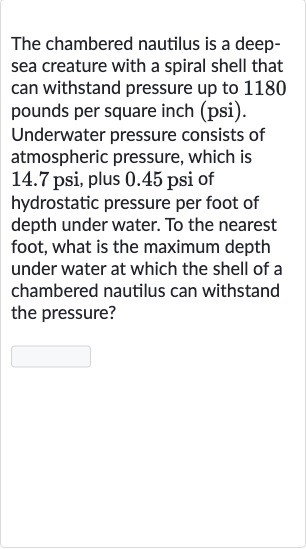AI tutor
Welcome to Bytelearn!
Let’s check out your problem:

The chambered nautilus is a deepsea creature with a spiral shell that can withstand pressure up to pounds per square inch (psi). Underwater pressure consists of atmospheric pressure, which is , plus of hydrostatic pressure per foot of depth under water. To the nearest foot, what is the maximum depth under water at which the shell of a chambered nautilus can withstand the pressure?
Full solution
Q. The chambered nautilus is a deepsea creature with a spiral shell that can withstand pressure up to pounds per square inch (psi). Underwater pressure consists of atmospheric pressure, which is , plus of hydrostatic pressure per foot of depth under water. To the nearest foot, what is the maximum depth under water at which the shell of a chambered nautilus can withstand the pressure?
- Understand Total Pressure: First, we need to understand the total pressure that the nautilus shell can withstand, which is given as . This includes both the atmospheric pressure and the hydrostatic pressure due to the water depth.
- Calculate Atmospheric Pressure: The atmospheric pressure is constant at . We need to subtract this from the total pressure the shell can withstand to find out how much pressure is left for the hydrostatic pressure. So, we calculate .
- Calculate Hydrostatic Pressure: Performing the subtraction, we get . This is the amount of pressure that can be attributed to the water depth alone.
- Find Maximum Depth: Now, we know that every foot of depth adds of hydrostatic pressure. To find the maximum depth, we divide the hydrostatic pressure the shell can withstand () by the pressure added per foot of depth (). So, we calculate .
- Determine Nearest Foot: Performing the division, we get . This is the depth at which the hydrostatic pressure equals the pressure the nautilus shell can withstand. Since the question asks for the maximum depth to the nearest foot, we do not need to round the number because it is already an integer. Therefore, the maximum depth is .
More problems from Pythagorean theorem
QuestionGet tutor help
QuestionGet tutor help
QuestionGet tutor help
QuestionGet tutor help
QuestionGet tutor help
QuestionGet tutor help
QuestionGet tutor help
QuestionGet tutor help
QuestionGet tutor help
